VANADOO®

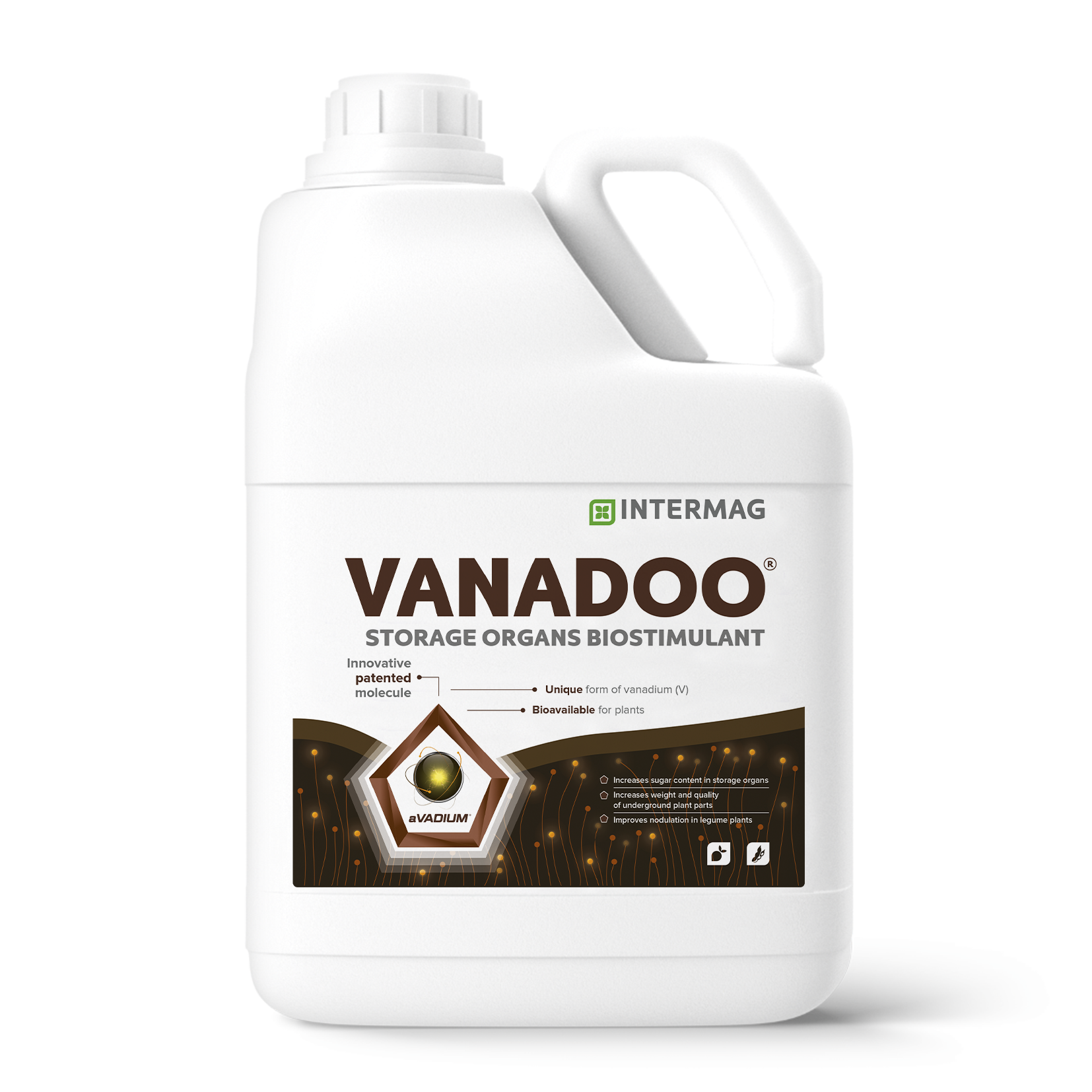
VANADOO® is an innovative and unique biostimulant, recommended in cultivation of plants, which underground storage organs are intended for harvest. VANADOO® owes its effectiveness to aVADIUM® – unique, patented molecule of vanadium.
VANADOO® – BENEFITS
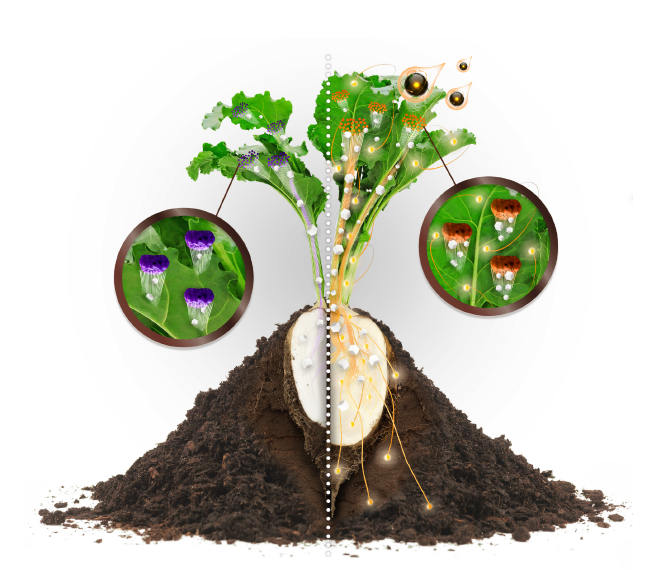
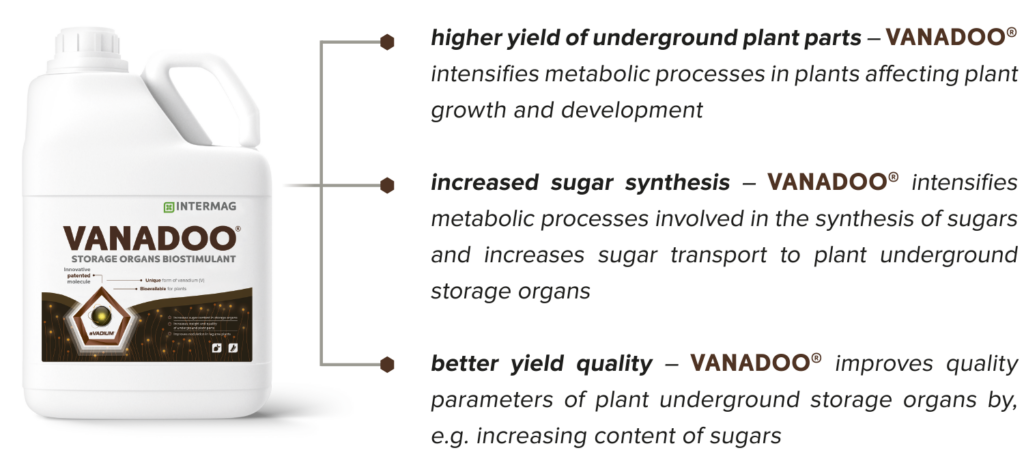
Vanadium (V), discovered in 1801, is a chemical element belonging to the group of transition metals. In the periodic table it is located next to titanium (Ti). Thanks to the studies carried out by scientist around the world we have known vanadium properties and possibilities of its utilization.
Vanadium compounds naturally occur in more than 60 minerals. This element is not mobile in the soil, therefore its availability to plants is limited. Vanadium is considered as beneficial element for plants.
VANADOO® is unique, innovative biostimulant, positively affecting yield quantity and quality of plant underground storage organs. VANADOO® is recommended in cultivation of plants, which underground storage organs are intended for harvest.
VANADOO® is based on aVADIUM® – bioavailable, organic vanadium compound. Development of aVADIUM® resulted from the studies on the effect of vanadium compounds on plants, carried out by INTERMAG. aVADIUM® is a key to the effectiveness of VANADOO®.
VANADOO® – is effective thanks to aVADIUM® molecule
aVADIUM® is:

Unique molecule aVADIUM® was created thanks to the advanced technology of binding vanadium to the organic molecule. Vanadium in a form of aVADIUM® is effectively provided to plants.
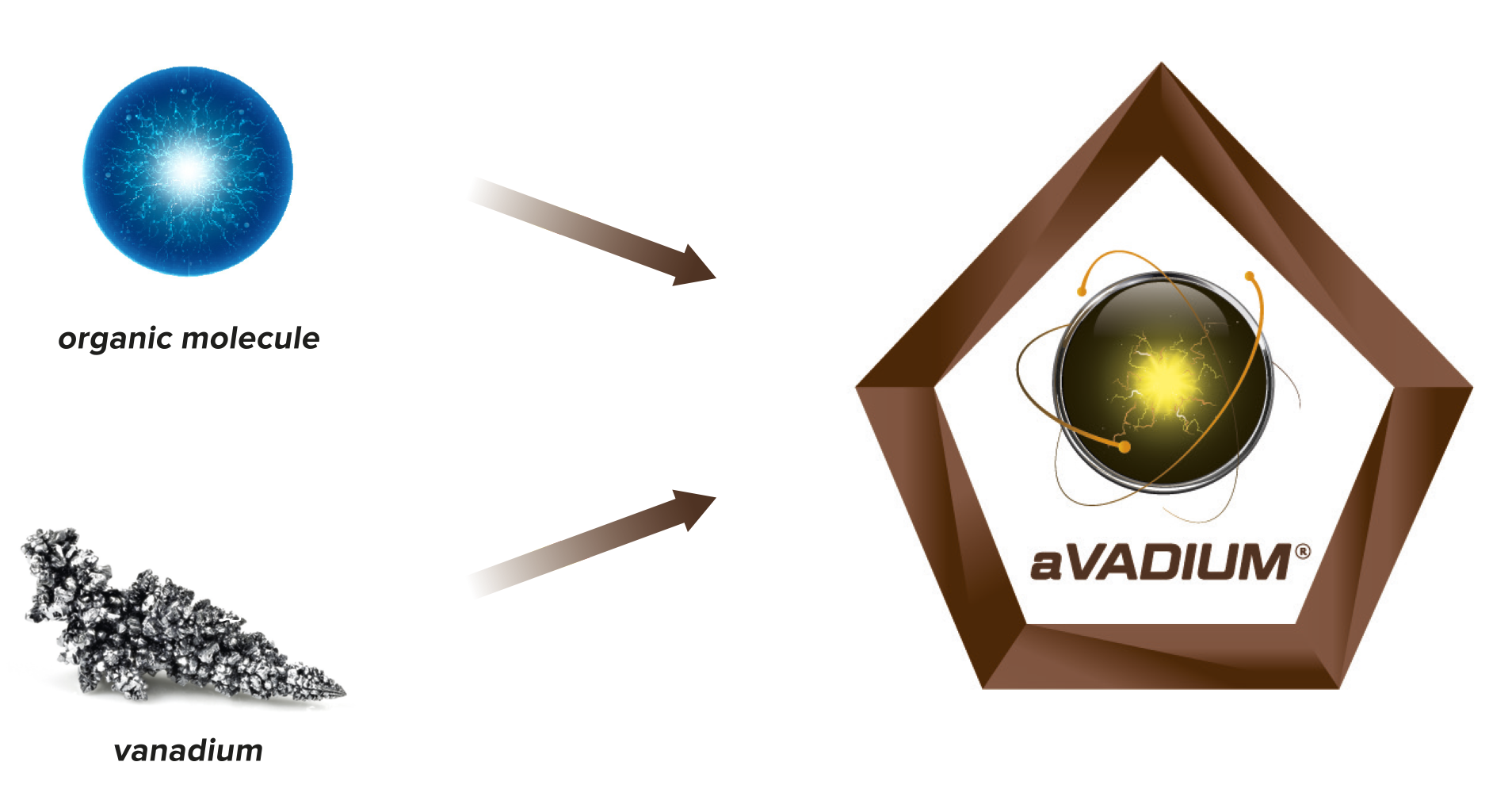
VANADOO® – APPLICATION
* number of treatments should be adjusted to plant vigor and growing conditions
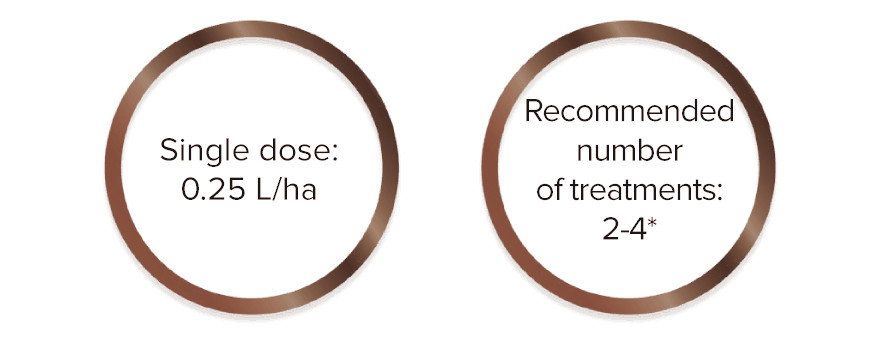
VANADOO® – RESEARCH RESULTS
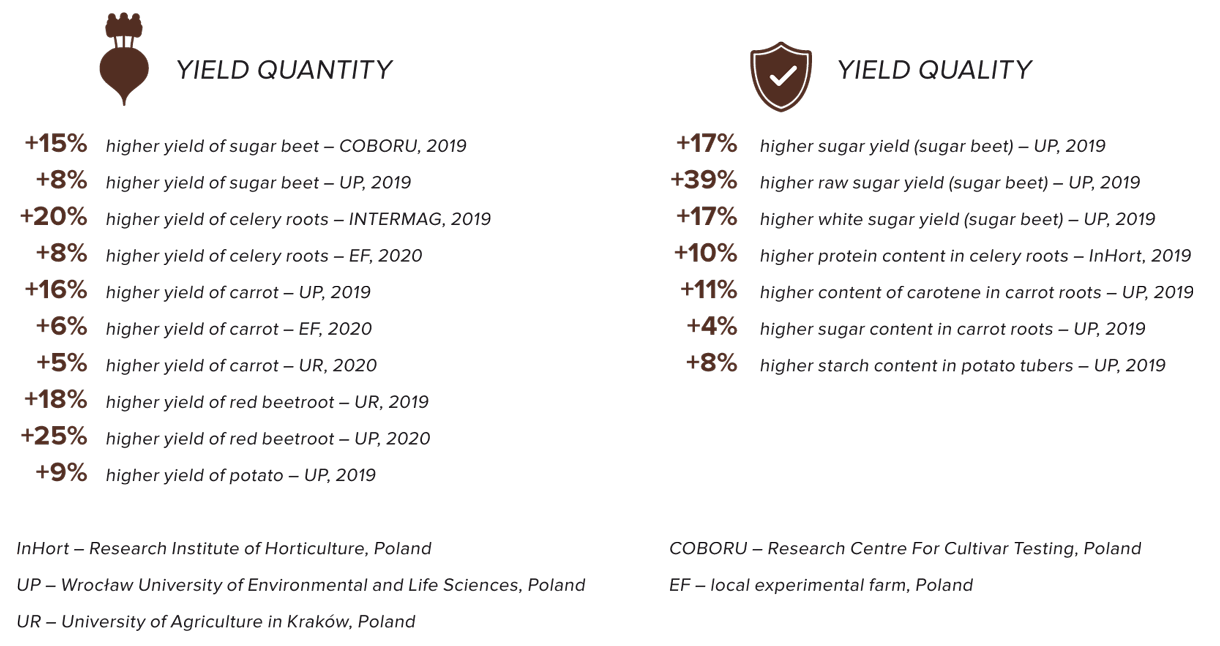
Results of the studies confirming the effectiveness of VANADOO®.
VANADOO® – PROFITABILITY
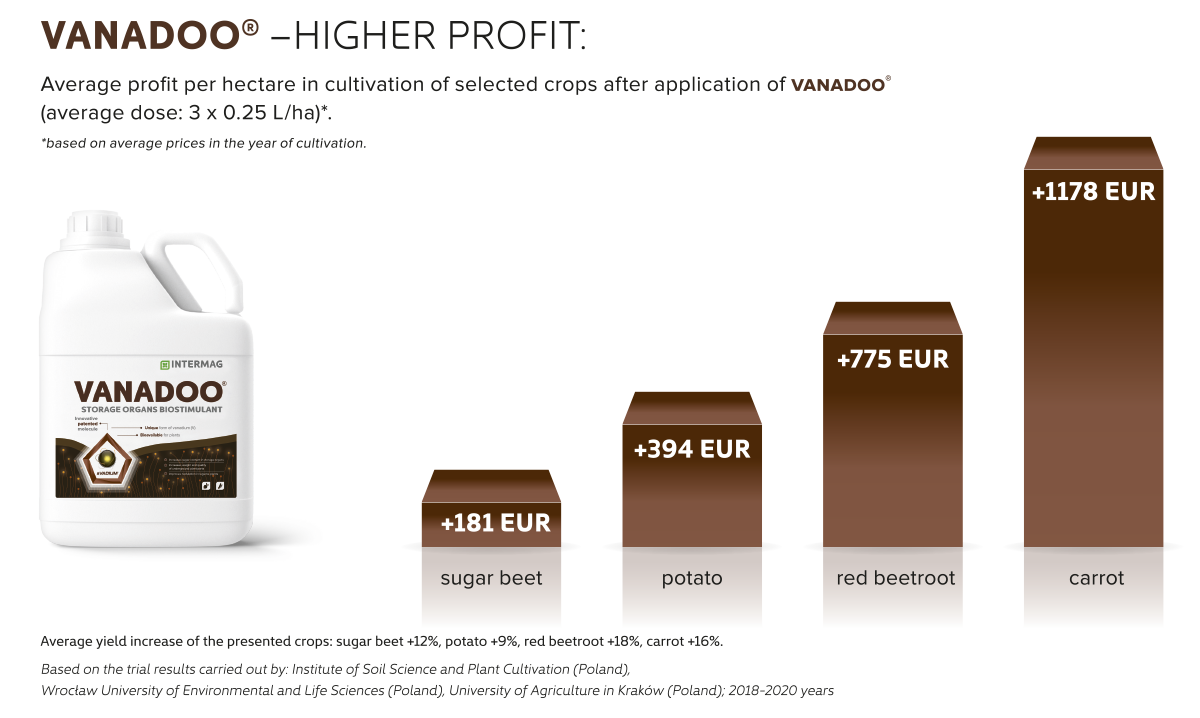
VANADOO® – LEARN MORE
FREQUENTLY ASKED QUESTIONS
- intensification of sugar synthesis
- better transport of sugars to storage organs
- greater accumulation of sugars in storage organs
VANADOO® contains 1.8% (m/m) of vanadium.
CROP GUIDES
| Application times for foliar treatments (◆ optimal, ◇ optional): | Direction for use: |
| ◆ beginning of leaf development | Foliar treatments – single dose 0.25 l/ha |
| ◆ beginning of crop cover | |
| ◆ beginning of storage root development |
| Application times for foliar treatments (◆ optimal, ◇ optional): | Direction for use: |
| ◆ beginning of growth of shoots and leaves (plant height about 10 cm) | Foliar treatments – single dose 0.25 l/ha |
| ◆ beginning of tuber growth | |
| ◇/◆ tubers reach ca. 50% of the final mass The treatment should be considered as optimal in case of growing of starchy potatoes. |
| Application times for foliar treatments (◆ optimal, ◇ optional): | Direction for use: |
| ◆ first trifoliate leaf development | Foliar treatments – single dose 0.25 l/ha |
| ◆ beginning of growth of shoots |
| Application times for foliar treatments (◆ optimal, ◇ optional): | Direction for use: |
| ◆ first trifoliate leaf development | Foliar treatments – single dose 0.25 l/ha |
| ◆ beginning of growth of shoots |
| Application times for foliar treatments (◆ optimal, ◇ optional): | Direction for use: |
| ◆ first trifoliate leaf development | Foliar treatments – single dose 0.25 l/ha |
| ◆ beginning of growth of shoots |
| Application times for foliar treatments (◆ optimal, ◇ optional): | Direction for use: |
| ◆ first trifoliate leaf development | Foliar treatments – single dose 0.25 l/ha |
| ◆ beginning of growth of shoots |
| Application times for foliar treatments (◆ optimal, ◇ optional): | Direction for use: |
| ◆ first trifoliate leaf development | Foliar treatments – single dose 0.25 l/ha |
| ◆ beginning of growth of shoots |
| Application times for foliar treatments (◆ optimal, ◇ optional): | Direction for use: |
| ◆ first trifoliate leaf development | Foliar treatments – single dose 0.25 l/ha |
| ◆ beginning of growth of shoots |
| Application times for foliar treatments (◆ optimal, ◇ optional): | Direction for use: |
| ◆ first true leaf development | Foliar treatments – single dose 0.25 l/ha |
| ◆ beginning of growth of shoots |
| Application times for foliar treatments (◆ optimal, ◇ optional): | Direction for use: |
| ◆ first true leaf development | Foliar treatments – single dose 0.25 l/ha |
| ◆ beginning of growth of shoots |
| Application times for foliar treatments (◆ optimal, ◇ optional): | Direction for use: |
| ◆ first true leaf development | Foliar treatments – single dose 0.25 l/ha |
| ◆ beginning of growth of shoots |
| Application times for foliar treatments (◆ optimal, ◇ optional): | Direction for use: |
| ◆ after seedling adaptation to the field conditions | Foliar treatments – single dose 0.25 L/ha. |
| ◆ beginning of inflorescence emergence | |
| ◆ beginning of flowering | |
| ◆ fruit development | |
| ◇ full yielding |
| Application times for foliar treatments (◆ optimal, ◇ optional): | Direction for use: |
| ◆ after seedling adaptation to the field conditions | Foliar treatments – single dose 0.25 L/ha. |
| ◆ the first inflorescence emergence | |
| ◆ beginning of flowering | |
| ◆ beginning of the first fruit development | |
| ◇ after the following harvest |
| Application times for foliar treatments (◆ optimal, ◇ optional): | Direction for use: |
| ◆ after seedling adaptation to the field conditions | Foliar treatments – single dose 0.25 L/ha. |
| ◆ the first flower bud emergence | |
| ◆ beginning of flowering | |
| ◆ beginning of the fruit development | |
| ◇ after the following harvest |
| Application times for foliar treatments (◆ optimal, ◇ optional): | Direction for use: |
| ◆ 3rd–5th leaf clearly visible | Foliar treatments – single dose 0.25 L/ha. |
| ◆ beginning of onion bulb formation | |
| ◇ bulb of onion reach 30–50% of the expected size |
| Application times for foliar treatments (◆ optimal, ◇ optional): | Direction for use: |
| ◆ growth of leaves | Foliar treatments – single dose 0.25 L/ha. |
| ◆ beginning of onion bulb formation | |
| ◇ bulb of onion reach 30–50% of the expected size |
| Application times for foliar treatments (◆ optimal, ◇ optional): | Direction for use: |
| ◆ 3rd–5th leaf clearly visible | Foliar treatments – single dose 0.25 L/ha. |
| ◆ beginning of onion bulb formation | |
| ◇ bulb of onion reach 30–50% of the expected size |
| Application times for foliar treatments (◆ optimal, ◇ optional): | Direction for use: |
| ◆ 3rd–5th leaf clearly visible | Foliar treatments – single dose 0.25 L/ha. |
| Application times for foliar treatments (◆ optimal, ◇ optional): | Direction for use: |
| ◆ 3rd–5th leaf clearly visible | Foliar treatments – single dose 0.25 L/ha |
| ◆ beginning of garlic bulb formation | |
| ◇ bulb of garlic reach 30–50% of the expected size |
| Application times for foliar treatments (◆ optimal, ◇ optional): | Direction for use: |
| ◆ 3rd–5th leaf unfolded | Foliar treatments – single dose 0.25 L/ha |
| ◆ beginning of storage root formation | |
| ◇ the storage root reaches about 50% of its typical size |
| Application times for foliar treatments (◆ optimal, ◇ optional): | Direction for use: |
| ◆ 3rd–5th leaf unfolded | Foliar treatments – single dose 0.25 L/ha |
| ◆ beginning of storage root formation | |
| ◇ the storage root reaches about 50% of its typical size |
| Application times for foliar treatments (◆ optimal, ◇ optional): | Direction for use: |
| ◆ 3rd–5th leaf unfolded | Foliar treatments – single dose 0.25 L/ha |
| ◆ beginning of storage root formation | |
| ◇ the storage root reaches about 50% of its typical size |
| Application times for foliar treatments (◆ optimal, ◇ optional): | Direction for use: |
| ◆ beginning of leaf development | Foliar treatments – single dose 0.25 L/ha |
| ◆ beginning of storage root development | |
| ◇ storage root development |
| Application times for foliar treatments (◆ optimal, ◇ optional): | Direction for use: |
| ◆ beginning of leaf development | Foliar treatments – single dose 0.25 L/ha |
| ◆ beginning of storage root development | |
| ◇ storage root development |

